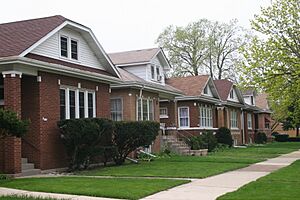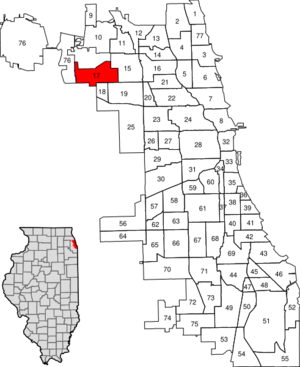Dunning, Chicago facts for kids
Quick facts for kids
Dunning
|
|
|---|---|
| Community Area 17 - Dunning | |

Schorsch Irving Park Gardens Historic District
|
|

Location within the city of Chicago
|
|
| Country | United States |
| State | Illinois |
| County | Cook |
| City | Chicago |
| Neighborhoods | |
| Area | |
| • Total | 3.75 sq mi (9.71 km2) |
| Population
(2020)
|
|
| • Total | 43,147 |
| • Density | 11,509/sq mi (4,443.6/km2) |
| Demographics 2015 | |
| • White | 65.87% |
| • Black | 2.41% |
| • Hispanic | 26.61% |
| • Asian | 4.13% |
| • Other | 0.99% |
| Time zone | UTC-6 (CST) |
| • Summer (DST) | UTC-5 (CDT) |
| ZIP Codes |
parts of 60634, 60635, 60707
|
| Median household income | $59,737 |
| Source: U.S. Census, Record Information Services | |
Dunning is one of the 77 official community areas in the city of Chicago, Illinois. It's also a neighborhood located on the Northwest Side of the city.
This area is home to Wilbur Wright College, a college where students learn. You can also find Mount Olive Cemetery and Zion Gardens Cemetery here. Plus, it's where the famous Eli's Cheesecake factory is located! Dunning is also the site of the Chicago-Read Mental Health Center, a hospital that helps people with mental health challenges.
History
Early Days in Dunning
In 1851, this quiet prairie area seemed perfect for Cook County's plans. They wanted to build a place for people who needed help, like those who were poor or had mental health issues. The county bought 160 acres of land for this purpose.
People living at the "poor farm" grew vegetables and went to school right there. Later, the place also helped people who were sick with tuberculosis. In 1870, a separate building was built for those needing mental health care. More buildings were added in the 1880s, making space for over 1,000 patients.
After the Civil War, a man named Andrew Dunning bought land nearby. He started a plant nursery and planned to create a village. He set aside 40 acres for homes, but not many people wanted to settle so close to the hospital.
Growing Up in Dunning
At first, getting to Dunning was hard. Trains brought workers from the city, but visitors had to walk a long way from the train station. In 1882, a train track was extended to the facilities. This "crazy train," as it was called, brought patients and supplies. The county built a station and named it Dunning.
In the 1880s and 1890s, Dunning was still mostly empty land. Cemeteries started to appear, like Mount Olive Cemetery in 1886. Jewish families also bought land for burials.
Around 1900, Henry Kolze turned his land into a picnic spot called Kolze's Grove. People loved visiting this beautiful area, especially after a streetcar line made it easier to get there. Other picnic spots, like Kosciuzko Grove, also opened in the Dunning area.
Over time, the hospital and poorhouse became very crowded. There were problems with how people were treated and the conditions were not good. In 1910, the poor farm moved to a new location. Two years later, the state bought the mental hospital. It was renamed Chicago State Hospital, but many still called it Dunning.
In 1989, during new building projects, old human remains were found. This led to the discovery of a forgotten burial ground where about 38,000 people were buried between the 1850s and 1920s. In 2002, a small park called Read Dunning Memorial Park was created to honor those buried there.
Dunning Today
By 1909, only 1,305 people lived outside the state facility. The first big housing boom happened in 1916. A real estate company bought land and called it West Portage Park to avoid the old name Dunning.
After World War I, Dunning's population grew to over 4,000 people. Many residents were from Swedish, German, and Polish families. In 1934, Wright Junior College was built. The population reached its highest point in 1970 with over 43,000 residents.
Today, Dunning is next to towns like Harwood Heights, Norridge, River Grove, and Elmwood Park. Many people who live here work for the city, like police officers and firefighters. The area is also close to the Harlem Irving Plaza shopping center.
In the 1980s and 1990s, Dunning started to grow again with new businesses and homes. Neighborhoods like Schorsch Village and Belmont Heights became popular. Luxury homes were built near a golf club. The Chicago-Read Mental Health Center got new, modern buildings. Wright Junior College also expanded with new, modern buildings. By 2000, the population had grown to over 42,000. In fact, one out of every three people in Dunning is of Polish descent, which is the highest rate for any ethnic group in a Chicago neighborhood!
| Historical population | |||
|---|---|---|---|
| Census | Pop. | %± | |
| 1930 | 19,659 | — | |
| 1940 | 23,328 | 18.7% | |
| 1950 | 32,231 | 38.2% | |
| 1960 | 41,626 | 29.1% | |
| 1970 | 43,843 | 5.3% | |
| 1980 | 37,860 | −13.6% | |
| 1990 | 36,957 | −2.4% | |
| 2000 | 42,164 | 14.1% | |
| 2010 | 44,664 | 5.9% | |
| 2020 | 43,147 | −3.4% | |
Notable People
- Andrzej Czuma: He was a government leader in Poland, serving as the 21st Polish Minister of Justice. He lived in Dunning when he was a political refugee from Poland.
- Chester P. Majewski: He was a member of the Illinois House of Representatives, which is part of the state's government.
- Danny Seraphine: He was a founding member and the former drummer for the famous band Chicago.

